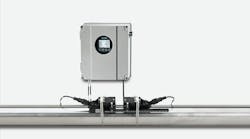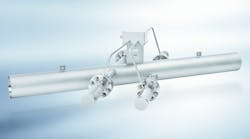Materials engineering company Morgan Advanced Materials has joined forces with UK-based Loughborough University to investigate the use of alumina blocks in new-generation ultrasonic flowmeters. Together, Morgan and Loughborough University’s Advanced Ceramics Research Group are exploring the potential use of reflective alumina blocks in place of the stainless steel blocks, which are currently widely used in these applications.
High-performance ultrasonic flowmeters have many applications, but in particular they are used in smart meters for utility and industrial flow measurement. Given the roll-out of smart meters worldwide, there is increased demand for accurate, reliable and durable ultrasonic flowmeters.
READ ALSO: How Ultrasonic Flowmeters Measure Natural Gas More Efficiently
Compared with traditional mechanical flowmeters, ultrasonic meters provide greater sensitivity, accuracy and longevity. This is largely due to their use of solid-state technology, which means they have no internal moving parts and so suffer no internal wear. That, in turn, means ultrasonic meters retain their accuracy over the long term.
In a fully assembled ultrasonic flowmeter, a pair of sensors is mounted in parallel to a flow tube, along with other electronic devices required. The meter calculates the flow rate of a medium, generally a liquid or gas, by assessing the delay in response between the two sensors, which are driven by electricity to create ultrasonic waves.
It is very important that the ultrasonic wave created by one sensor be transmitted to the other sensor with minimal loss. Blocks with an angled reflective surface are used to achieve this. The blocks must retain their reflective surface throughout service, since any loss or degradation of reflection will impair the transmission of the signal between sensors. Traditionally, stainless steel has been used to make such blocks, but as new technologies and possibilities come into view, it is important to investigate their qualities.
Morgan’s Technical Ceramics business manufactures ultrasonic flow sensors, using a special grade of piezoelectric ceramic, lead zirconate titanate (PZT). The Loughborough group, led by Professor Bala Vaidhyanathan, is focused on the understanding and characteriszation of technical materials. Together, the two organizations will evaluate the degradation of stainless steel and alumina ceramics, through a test that simulates 20 years of service within a flow tube. The alumina ceramics used in this research are all approved by the Water Regulations Advisory Scheme (WRAS), which approves the materials commonly used in water management applications.
Dr. Yifei Zhang of Morgan Advanced Materials believes this research partnership is likely to produce outcomes of significant interest and practical use, not only for Morgan but for many sectors and applications. "The accurate measurement of volume flow is important in many sectors, but at the moment there is particular interest in smart meters," Zhang said. "This growing commercial application fuels demand for highly accurate meters that are cost-effective and durable, which require novel materials to be applied in innovative new ways. We are proud to be working with Loughborough University on the type of research that will take technical ceramics—and ultrasonic flowmeters—into the future."


